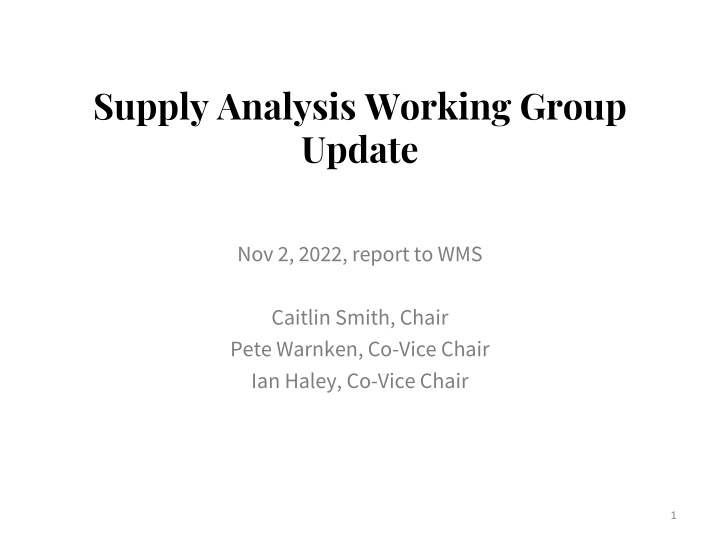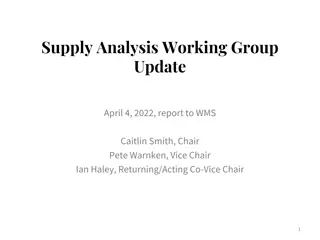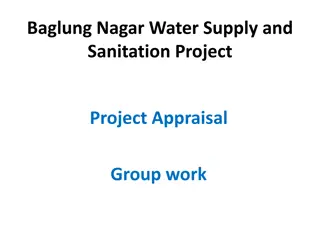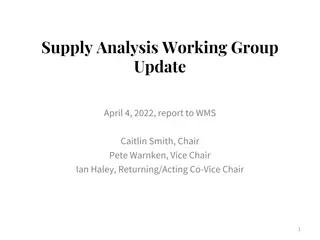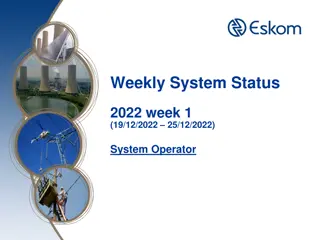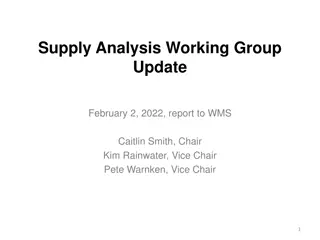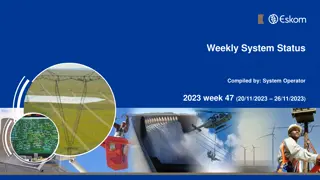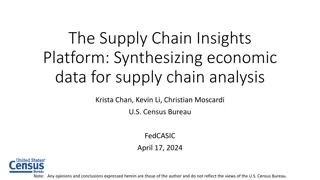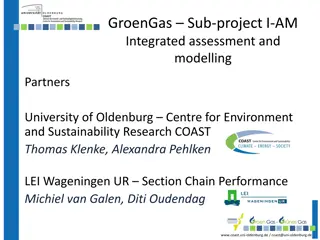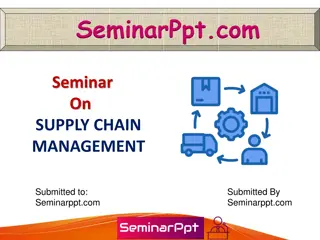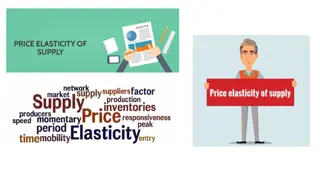Supply Analysis Working Group Update Nov. 2, 2022 Report Summary
The report provides key insights from the Supply Analysis Working Group update, focusing on zonal supply deliverability studies, reserve margin analysis, and ELCC findings. Various studies conducted by Astrape Consulting in 2026 are highlighted, including Perfect Capacity and Transmission Capability results. The report also delves into the effects of solar, wind, and storage technologies on net load shape and reliability. Detailed analysis and findings from different studies are outlined, emphasizing the importance of capacity planning and technology interactions in ensuring grid reliability.
Download Presentation

Please find below an Image/Link to download the presentation.
The content on the website is provided AS IS for your information and personal use only. It may not be sold, licensed, or shared on other websites without obtaining consent from the author.If you encounter any issues during the download, it is possible that the publisher has removed the file from their server.
You are allowed to download the files provided on this website for personal or commercial use, subject to the condition that they are used lawfully. All files are the property of their respective owners.
The content on the website is provided AS IS for your information and personal use only. It may not be sold, licensed, or shared on other websites without obtaining consent from the author.
E N D
Presentation Transcript
Supply Analysis Working Group Update Nov 2, 2022, report to WMS Caitlin Smith, Chair Pete Warnken, Co-Vice Chair Ian Haley, Co-Vice Chair 1
Zonal Supply Deliverability Study Astrape Consulting Proof of concept type study for use in 2023 Reserve Margin Study Background Determine base reliability assuming full transmission deliverability, and then coal capacity was retired until the system reached ~.1 LOLE Then switched out full transmission deliverability group for a more constrained grou Study Approaches Perfect Capacity Starting with the constrained group results, perfect capacity was added to each zone iteratively with the objective of adding the minimal net capacity in aggregate across ERCOT to achieve 0.1 LOLE in all zones Meeting this objective required reducing capacity in some zones Transmission Starting with the constrained group results, transmission limits were relaxed on each internal ERCOT transmission tie iteratively with the objective of minimal net adjustments to transmission capability across all zonal ties to meet 0.1 LOLE in all zones 2
Zonal Supply Deliverability Study Astrape Consulting 2026 Perfect Capacity Results 3
Zonal Supply Deliverability Study Astrape Consulting 2026 Transmission Capability Results 4
ELCC Study Astrape Consulting ELCC Study SERVM Simulations Solar 0 40 GW Wind 0 50 GW Storage 0 12 GW Analyze 2,4,8-hour durations Location Effects of Wind Location Effects of Solar Technology Effects of Solar ELCC Finding Summary (see next slide) Solar Initially (5-10 GW) solar flattens net load shape and has antagonistic relationship with storage. At higher penetrations solar ELCC is higher with more storage. Solar also exhibits a persistent, but much smaller synergistic relationship with wind penetration. Wind Wind has consistent synergy with solar driven by profile differences in wind and solar. Wind pushes net load earlier in the day. Solar pushes net load later in the day. These effects allow the other technology to provide more reliability value. Minimal interactive effects are seen between wind and storage with a small antagonistic effect at low storage penetration. Storage Storage ELCC has a strong synergy with solar particularly at high solar penetration (>20 GW). 5
ELCC Study Astrape Consulting - Location Effects of Wind & Solar 8
ELCC Study - Astrape Consulting - Resource ELCC by Technology Type (2024 Summer Portfolio) Next Steps j 9
ELCC Study - Astrape Consulting - Resource ELCC by Technology Type (2024 Winter Portfolio) Next Steps j 10
ELCC Study Next Steps Final ELCC Report To include also: Storage Combinations Thermal ELCCs ELCC Workshop Likely in mid November 11
2023 Reserve Margin Study Update: ERCOT and Astrape currently working on scope of work Winter 2022 CDR will be used as the input Kickoff study in early 2023 Sensitivities: Zonal Impact Estimate the impact of zonal constraints on EORM, MERM, and 0.1 LOLE RM. Renewable Penetration Higher underlying wind and solar penetration Energy Storage Participation Review market outcomes without the projected battery storage fleet EFOR Review market outcomes of varying the forced outage rates of the thermal units Solar-Battery Storage Reference Resource Solar-battery storage system used as the reference resource Non-Simulation Sensitivities VOLL Reference Resource Carrying Cost Weather Weightings Load Forecast Error Distribution 12
2023 Reserve Margin Study ERCOT looking for input at November 9th SAWG on additional sensitivities Joint SAWG/ERCOT Sensitivity Selection Retirement Risk Electrification Operating Reserves Co-Optimization Other SAWG Suggestion 13
CDR Modification Plan Initiatives Quarterly Release Post CDR reports on a quarterly basis that provide resource adequacy summaries as of the start of each future season (spring, summer, fall, winter) going out five years. Requires NPRR Separate Main and Data Reports Reconstitute the CDR into a main report in PowerPoint that features charts, tables, highlight text, and a link to the supporting data report. The data report consists of a dynamic dashboard using the Tableau Public data visualization platform, with access to detailed data tables. Resource Adequacy Scorecard The main report includes a resource adequacy scorecard that shows how the forecasted resource portfolio performs on a range of forward-looking measures. Examples include: Capacity Reserve Margin relative to EORM, MERM, and reliability-based levels. Energy adequacy measures, such as (1) seasonal Expected Unserved Energy (EUE) as a percentage of total energy relative to a standards-based level, (2) EUE depth Extreme net load risk measures for both capacity and energy. Examples of capacity measures include resource capacity margins needed to cover an extreme seasonal net load ramp and a worst-case net load scenario. An example of an energy measure is the Expected Unserved Ramp (EUR) for given periods. Requires PUCT rulemaking and approval 14
CDR Modification Plan Initiatives ELCC/UCAP Switch to Effective Load Carrying Capability (ELCC) values for inverter-based resources (wind, solar, energy storage). Switch to Unforced Capacity (UCAP) values for thermal resources, which involves lowering the seasonal sustained capacity ratings based on actual forced outage rates. Requires PUCT Rulemaking and rule language pertaining to capacity accreditation Reporting of Reserve Margins for Multiple Hours Report Reserve Margins for selected hours for each season that have the highest net load risks. Requires PUCT Rulemaking and approval of the multiple hour approval Reserve Margin Scenarios For risk assessment purposes, include scenarios with different Reserve Margin outcomes. Scenario assumption examples include the following: Use alternative load forecasts. Modify the forecasted planned resource capacity based on different sets of eligibility criteria. Incorporate the capacity impacts of Unconfirmed Retirements as defined in the current CDR reports. Need NPRR if not part of a PUCT Rulemaking 15
CDR Modification Plan Initiatives Modify CDR Inclusion Eligibility for Planned Projects Add an additional criterion for including planned capacity in the CDR: Receipt of a TSP written notice from the Interconnecting Entity that the IE has provided a notice to proceed with the interconnection facility construction and has proof of financial security to fund the facility construction. Requires NPRR Include Unconfirmed Retirements in Reserve Margins Include Unconfirmed Retirement capacity as a resource line item that impacts the CDR Reserve Margin and other measures. Requires NPRR Multiple Solar Regions Develop two or three Solar Regions for ELCC estimation and geographical reporting (e.g., Far West, West and non-West). Requires NPRR LFL Reporting Incorporate Large Flexible Load information in the CDR per the LFL white paper approved by the LFL Task Force (Issue number LFL-49). Require NPRR 16
CDR Modification Plan Initiatives Report Total Unregistered DG Include a new demand adjustment line item for Unregistered Distributed Generation (principally rooftop solar). Unregistered DG is accounted for in the Long-Term Load Forecast, and there is an Unregistered DG report that captures most of the capacity. This initiative is intended to consolidate and expand the reported capacity amounts. May need NPRR language that addresses DG forecasting if stakeholders want that formally included in the CDR. Requires NPRR language to remove the facility reporting size threshold in the Unregistered DG report, or establish another data collection mechanism in lieu of the one used for the Unregistered DG report (load profile submissions from competitive areas, and Excel form submissions from NOIEs. Capacity contribution for fossil fueled SODGs Assign a capacity contribution for fossil fueled Settlement Only Distributed Generators (SODGs). These SODGs are currently identified in the CDR report, but are not included in the Reserve Margin calculation. Requires an NPRR (preliminary draft NPRR was prepared and presented to SAWG in May 2021). DG breakout of ERS Generator and Load capacity Divide the current single Emergency Response Service capacity line item into two items distinguishing capacity associated with Distributed Generators and Load Resources. May require NPRR 17
Other Business Next SAWG: November 9th Long Term Load Forecast Presentation Feedback on 2023 Reserve Margin Sensitivities Astrape ELCC Report ELCC Workshop ~November 14th-16th CDR & SARA Release Plan to release both at same time ~Last week of November 18
